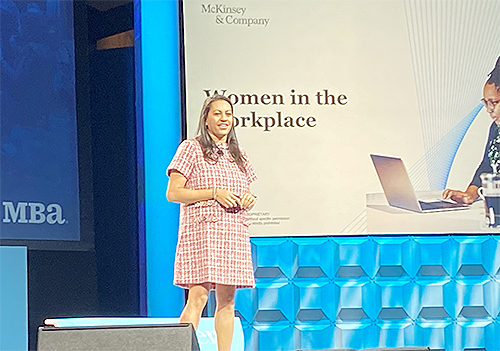
McKinsey’s Laura Webanck: Gender Equality Sees Some Gains, but Challenges Remain

(Webanck presents the research; Image by Anneliese Mahoney)
PHILADELPHIA–While some areas of gender equality are improving in our workplaces, there are still notable myths and issues to combat, per a recent study from McKinsey Co., New York, presented at the mPowering You Summit for Women in Real Estate Finance here Oct. 14.
Laura Webanck, a Partner in McKinsey’s New York office, provided attendees with a rundown of “Women in the Workplace 2023,” released about a week and a half prior.
In terms of good news: according to the study, in 2015, 17% of the C-Suite was women. In 2022, it was at 22%, and now it’s 28%. Representation of women at the VP and SVP levels have also improved, each up about 4% in the past five years.
But, progress has slowed when it comes to women at the manager and director levels.
“That leaves strikingly fewer women in line for those top positions. Women of color face the steepest drop off in representation from entry level all the way out to the C suite, Webanck said. “[The drop off is] 18% to 6% for corporate America at large. But for banking and consumer finance, we do worse. It goes from 25% to 6%.”
Webanck said debunking the myths about women in the workplace can help shed light on some of the problems.
Myth One: Women Are Becoming Less Ambitious
That’s simply not true, Webanck said–women are in fact reporting higher rates of ambition than pre-pandemic, and levels in line with men.
In 2019, roughly seven in ten women said they wanted to be promoted to the next level this year; that metric is up to eight in 10 this year. And, 88% of women of color say they want to be promoted.
Myth Two: The “Glass Ceiling” Keeps Women From Achieving
Webanck pushed back against the popular myth of the “the glass ceiling.”
“The problem starts much earlier. Our data points to a bigger problem earlier in the pipeline: The broken rung, which is that first promotion from entry level to manager,” Webanck said.
The numbers are stark: For every 100 men promoted to manager, only 87 women are promoted, and only 73 women of color are promoted. Moreover, the women of color promoted in the last year dropped from 82 (compared to the 100 men) to 73.
“We will never get to our gender parity objectives without addressing the broken rung. If you’re going to ask your institutions to focus on anything, start here,” she continued.
Myth Three: Microaggressions Have a “Micro” Impact
Webanck pointed to the “macro” impact of microagressions–demeaning or dismissive comments and actions, rooted in bias, that are directed at someone due to their gender, race or other aspect of their identity.
Women experience microagressions at a rate of one and half to two times more than men.
“Women with disabilities and LGBTQ-plus women are nearly two and a half times more likely than men to have their judgment questioned in the workplace,” Webanck said. “Asian women and black women are seven times more likely than men to be confused with someone of the same race or nationality.”
Women who experience microagressions are 14% less satisfied with their organization, 25% are more likely to say they feel burned out most of the time and they’re 37% more likely to consider leaving or looking for a new job.
Myth Four: Women Are More Likely to Want and Benefit From Flexibility
The need for flexibility at work was a constant theme throughout Webanck’s session.
And that’s not just for women–both men and women cite flexibility (opportunities to work remotely and control over when you work) in their top three most important benefits. Only health care benefits rank more highly.
Webanck said there’s a disconnect between what employees want and employer perceptions. “Less than 10% of HR leaders think that offering significant flexibility–where and when employees work–as a top three driver of the company’s future talent,” she said.
What’s Next?
Ultimately, why is addressing gender diversity–and diversity, equity and inclusion, generally–so important? Webanck noted that DE&I drives outsized returns and attracts talent.
Gender diverse companies, she said, outperform their peers by 25%. Ethnically diverse companies outperform their peers by 36%.
In order to address the four myths and resulting issues, Webanck provided a number of recommendations for employers. For example, they need to dig into their data and figure out where in their pipeline they are seeing issues–is the broken rung present?
Employers also need to fine-tune their flexibility options, put effort into combatting microaggressions and work with their managers to provide resources, training and support.
Webanck also noted the need for consistency in DE&I efforts. “Let’s make sure we’re actually setting goals. We are holding individuals accountable for helping us reach those goals,” she said. “We need to be able to figure out what’s working and what’s not, to reach those goals ultimately.”
